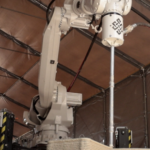3D printing techniques have been helping many fields to improve, such as the medical one. Whether it comes to a 3D printed pelvis or jaw or even a skull replacement, the technique has proven its ability to improve and save lives. British doctors at Southampton Hospital have now used the technology to create a hip replacement for a 71-year-old woman, using stem cells and a CT scan.
Meryl Richards has had a car accident back in 1977 and the woman suffered from a painful hip ever since. She has had as many as six operations since, but they weren’t successful on the long run. Doctors therefore tried the possibility of 3D printing a hip in order to achieve a longer sustaining success.
The reason they think a 3D printed hip could be a good benefit to the 71-year-old woman is that the technique enables them to create a more precisely fitted hip. During such methods doctors use a CT scan, which provides them with precisely measured data. They can then turn those data – the 3D model – into a 3D printed hip, therefore using a three-dimensional printer.
In order to regrow new bone around the hip, they also used stem cells. This enabled the doctors to make the hip fit perfectly and it lowered chances of having to operate the woman again in the future. Of course, the doctors don’t know yet whether this operation will be sufficient or not, but there is a good chance for it to be. Doctors therefore called this operation a “game changer”.
“The benefits to the patient through this pioneering procedure are numerous,” says Douglas Dunlop, consultant orthopaedic surgeon. “The titanium used to make the hip is more durable and has been printed to match the patient’s exact measurements – this should improve fit and could reduce the risk of having to have another surgery. The bone graft material that has been used has excellent biocompatibility and strength and will fill the defect behind the bone well, fusing it all together.”
“The 3D printing of the implant in titanium, from CAT scans of the patient and stem cell graft is cutting edge and offers the possibility of improved outcomes for patients,” adds Professor Richard Oreffo, at the University of Southampton. “Fractures and bone loss due to trauma or disease are a significant clinical and socioeconomic problem. Growing bone at the point of injury alongside a hip implant that has been designed to the exact fit of the patient is exciting and offers real opportunities for improved recovery and quality of life.”
Mrs Richards herself is very excited about the operation: “The way medicine has evolved is fantastic. I hope that this will be the last time that I have to have a hip operation. I feel excited to have this pioneering surgery and I can see what a benefit it will have to me.”
Image credits: University of Southampton/ Naval Technology.










